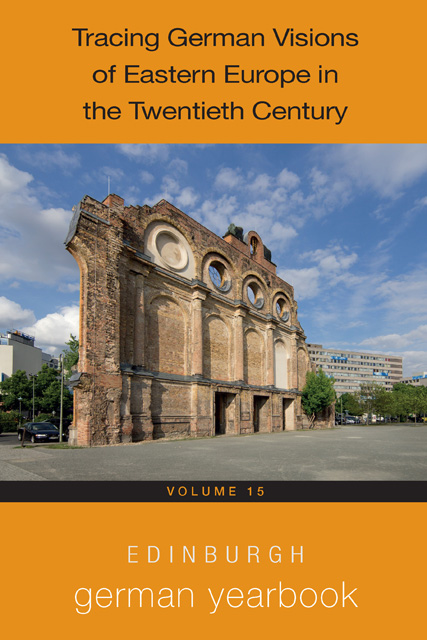Book contents
- Frontmatter
- Contents
- Miscellaneous Frontmatter
- Between Estrangement and Entanglement: An Introduction to German Visions of Eastern Europe in the Twentieth (and Twenty-First) Century
- Colonizing a Central European City: Transnational Perspectives on Kronstadt/Braşov/Brassó in the First Half of the Twentieth Century
- Exile as a Literary-Political Mission: Leo Katz’s Antifascist Bukovina Novel Totenjäger (1944)
- Brunnenland: The Image of the Bukovina in Paul Celan
- “Auch bei uns im fernen Transsilvanien”: The Transylvanian Saxons and the Long Shadow of the Third Reich in the Work of Bettina Schuller
- Through an Orientalist Lens: Colonial Renderings of Poland in German Cinema after 1989
- The Nazi Ghost and the Sinti Woman in Kerstin Hensel’s Bell Vedere (1982)
- The Haunted Landscape of Babi Yar: Memory, Language, and the Exploration of Holocaust Spaces in Katja Petrowskaja’s Vielleicht Esther (2014)
- “dann hüpfe ich auch, komisch und ungeschickt, wie eine Nadel auf einer abgespielten Platte …”: Translational Ethics and Affects in Katja Petrowskaja’s Vielleicht Esther (2014)
- Expanding the Nationalgeschichte: Multidirectional European Memory in Nino Haratischwili and Saša Stanišić
- Reading Photographic Images and Identifying Mnemonic Threads of the Post-Memorial Project in Sie kam aus Mariupol (2017) by Natascha Wodin
- Navid Kermani’s Entlang den Gräben (2018) and Its Readers: Remapping Europe’s East
- Notes on the Contributors
Between Estrangement and Entanglement: An Introduction to German Visions of Eastern Europe in the Twentieth (and Twenty-First) Century
Published online by Cambridge University Press: 11 January 2023
- Frontmatter
- Contents
- Miscellaneous Frontmatter
- Between Estrangement and Entanglement: An Introduction to German Visions of Eastern Europe in the Twentieth (and Twenty-First) Century
- Colonizing a Central European City: Transnational Perspectives on Kronstadt/Braşov/Brassó in the First Half of the Twentieth Century
- Exile as a Literary-Political Mission: Leo Katz’s Antifascist Bukovina Novel Totenjäger (1944)
- Brunnenland: The Image of the Bukovina in Paul Celan
- “Auch bei uns im fernen Transsilvanien”: The Transylvanian Saxons and the Long Shadow of the Third Reich in the Work of Bettina Schuller
- Through an Orientalist Lens: Colonial Renderings of Poland in German Cinema after 1989
- The Nazi Ghost and the Sinti Woman in Kerstin Hensel’s Bell Vedere (1982)
- The Haunted Landscape of Babi Yar: Memory, Language, and the Exploration of Holocaust Spaces in Katja Petrowskaja’s Vielleicht Esther (2014)
- “dann hüpfe ich auch, komisch und ungeschickt, wie eine Nadel auf einer abgespielten Platte …”: Translational Ethics and Affects in Katja Petrowskaja’s Vielleicht Esther (2014)
- Expanding the Nationalgeschichte: Multidirectional European Memory in Nino Haratischwili and Saša Stanišić
- Reading Photographic Images and Identifying Mnemonic Threads of the Post-Memorial Project in Sie kam aus Mariupol (2017) by Natascha Wodin
- Navid Kermani’s Entlang den Gräben (2018) and Its Readers: Remapping Europe’s East
- Notes on the Contributors
Summary
German collective and cultural identity is unthinkable without “the East.” From the nascent nationalist discourses of the eighteenth century to the anti-communist paranoia of the Cold War, Germany has projected its fears of annihilation and dreams of cultural ascendancy onto the lands of Eastern Europe. Although Germany is frequently discussed in terms of lateness—the late formation of a German nation-state, the late emergence of a coherent German national identity—the vision of Eastern Europe as the “Other” of the German-speaking lands is long-standing and remarkably consistent. Conceptions of the “East” as a homogenized and alien imaginary space emerge in medieval poetry and crusader discourse of the Holy Roman Empire, and reappear across the centuries in new permutations. Eastern Europeans were demonized as inherently violent and ungodly in the context of the religious wars of the Reformation, conflict between the Habsburg and Ottoman Empires, fears around the Polish national revival of the nineteenth century, and the anticommunist hysteria of the early twentieth century, while tropes of vastness, hostility, and alterity associated with the Eastern European landscape persist largely unchanged from the travel literature of the Enlightenment to the Eastern Front novels of the 1950s. Likewise, the vaunting of Eastern Europe as a space offering opportunities for profit, adventure, and self-realization, which reached its apotheosis in the literature of the nineteenth century, has not vanished in the German sphere, even if concrete expansionism is tainted by its association with National Socialism. As several contributions to this volume highlight, Germany continues to look eastward for revitalization when it comes to the arts and culture, not to mention labor and trade. The increased attention to Eastern European experiences of the Second World War seen in Anglophone and German-language historiography in recent years is mirrored in publishing trends that suggest that Germany is currently also in the process of turning East when it comes to its memory culture. With the success of Germany’s denazification under fresh interrogation, the “rediscovery” of less remembered dimensions of Holocaust history sees Eastern Europe once again coded as unknown yet fertile terrain for exploring German collective identity.
The enduring significance of “the East” to the self-fashioning of the German people from the High Middle Ages to the twentieth century is especially interesting because of the relative intimacy between German-speaking and non-German-speaking people across Central and Eastern Europe throughout the same period.
- Type
- Chapter
- Information
- Edinburgh German Yearbook 15Tracing German Visions of Eastern Europe in the Twentieth Century, pp. 1 - 34Publisher: Boydell & BrewerPrint publication year: 2022

